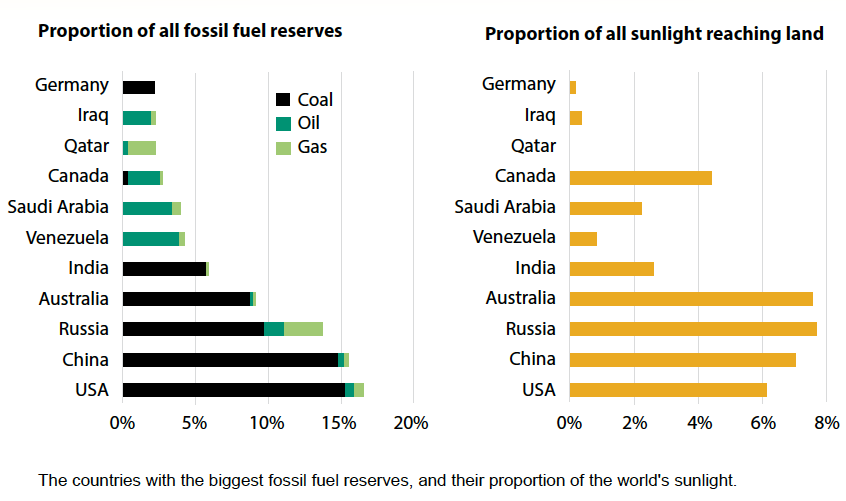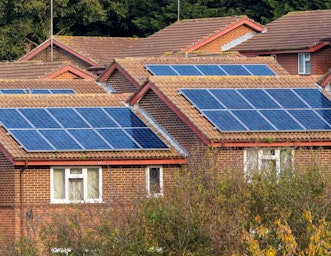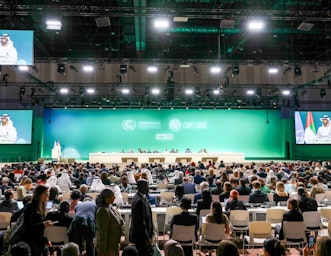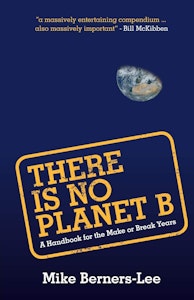
A wide-ranging new work by Mike Berners-Lee looks at some of the urgent questions facing humanity. There is No Planet B: A Handbook for the Make or Break Years covers everything from tackling climate change to the future of work. In this edited extract, he explores how we can keep fossil fuels in the ground.
Does more renewables mean less fossil fuel?

Not necessarily. The big question is whether we will have the renewables as well as or instead of the coal, oil and gas.
The past 150 years of energy history tells us that the arrival of new sources have dented but not stopped the growth of other energy sources. Oil softened the rise of coal somewhat, but it continued to grow. Later, the arrival of gas only softened the growth in oil. When a new source comes along we have traditionally used more energy in total, but we have also felt relatively energy-rich for a while and the hunger for other sources has somewhat slackened.
A huge surge in solar and other renewables could give us a period in which it is relatively easy to let go of fossil fuels, but it won’t be enough to make it happen automatically. Policymakers need to get their heads around this. Please don’t vote for any who haven’t.
What is the catch with energy efficiency?
It goes hand in hand with an even greater increase in demand for whatever the energy is used for.
In 1865 William Stanley Jevons spotted that if the UK used coal more efficiently it would end up wanting more of it, not less. This phenomenon has become known as the Jevons Paradox.
Energy efficiency leads, by default, to an increase in total demand, rather than the decrease that is often assumed. It applies just as widely today as it did in 1865 and it has game changing implications for energy and climate policy. It may be counterintuitive at first but makes perfect sense on reflection.
Look at it this way. Imagine if it took a tonne of coal to keep a family warm for one night and that family saves up to enjoy one warm winter evening – a New Year celebration perhaps. Now imagine that a more efficient burner is invented, and the same tonne of coal can keep them warm for two nights. Coal has just become twice as valuable to them, so they make extra effort to buy enough to keep themselves warm for three nights in the year. They might spend one of those nights fitting new insulation so that the coal becomes even more useful to them and the other night working by the fire to earn the extra money they need for their increased coal budget. However, the price of coal per tonne comes down a bit to help them because demand is going up so much and economies of scale are kicking in, along with a stack of investment in new extraction technologies. And so it goes on. This is just a caricature of how the Jevons Paradox works, but I hope it demonstrates the principle.
Over the years we have become many times more efficient in our production of just about everything. LED lighting is hundreds of times more energy efficient than oil and gas lamps. Microchips are millions of times more efficient at storing data than paper, and the cloud more efficient still. Electric trains are many times more efficient than steam trains, let alone horses. Yet our energy usage has risen hand in hand with those efficiencies and is actually enabled by them.
In fact, we can see that we don’t use more energy despite the efficiency gains, but rather we are able to use more energy because of the efficiency gains. Wow! Feel free to pause at this point and reflect on the gigantic policy implications of this perspective. It means that whilst efficiency gains help us get more benefit from any given amount of energy, they also end up leading to an increase in total consumption unless that is deliberately constrained.
Just before you go ripping out all your double glazing and deflating your tyres, note that I am not saying that efficiency gains cannot be useful in the future. But I am saying they are no good at all on their own.
Given the catch, what can efficiency do for us?
We badly need more efficiency, but we also need to learn not to squander it with increased consumption.
We have to make efficiency work for us in a different way than we are used to. From now on when we get an efficiency improvement we have to deliberately bank the savings rather than allowing the default outcome in which our consumption appetite increases and the savings are lost through a myriad of rebound effects. This is a critically different approach to adopt at the point of consumption.
The way to make it work is to have a constraint on total use of resources, and in particular fossil fuels. When fossil fuel use is forced downwards, rebound effects will cease. The dynamic will change. Efficiency will suddenly become a force for wellbeing that will, for the first time, come without hidden, detrimental environmental consequences.
Under these conditions, efficiency will be one of the key routes to having the things we need and want.
How can we keep the fuel in the ground?

Since green energy on its own won’t help much and efficiency on its own won’t help at all, there is no escaping the need for a constraint on extraction.
The fossil fuel we use will be the gap between the clean energy supply and the total energy use. Straight away that gives us two clear levers; push the green supply up and hold the demand down. A third lever is to constrain the fossil fuel supply. This hard cap will end the rebound effect on carbon emissions.
To push the clean energy supply up, we need to invest in it hard. This includes the global rolling out of the renewable (especially solar) supply and the infrastructure to go with it, as well as the research and development into the rack of accompanying technologies that will be required to make solar work for us: storage, electric transport and so on. All this is doable.
Where does the money come from? As luck would have it a whole lot of investment opportunity is created by the divestment from fossil fuels. The switch from yesterday’s energy system to tomorrow’s is loaded with business opportunities, and it will be net positive for jobs as well.
To constrain the supply, it is no good hoping that renewables will be so good that we lose interest in the coal and can’t be bothered to dig it up. And it is no good hoping that just some parts of the world doing the right thing we will get somewhere. We need an enforceable global deal to leave the fuel in the ground. It doesn’t matter how hard you think this is to achieve, because nothing else will do. The 2015 Paris Agreement was progress towards that, although leaving a long way yet to go. Subsequent climate talks in Marrakech and Bonn have barely inched us any closer.
For such a deal to be possible, there are some conditions that will need to be in place. A limited amount of fossil fuel remaining in the total carbon budget will somehow need to be shared out and the very different ways in which countries will be affected by such a deal need to be taken into account, because unless it works for everyone, it won’t happen.
The early stages of climatic change also look very different in different parts of the world. While the Maldives sinks, Bangladesh floods, and California burns, Russia is likely to find its crop yields going up at first, its ports becoming ice free for twelve months of the year instead of eight, and yet more of its fossil energy reserves becoming accessible. In poorer countries a carbon constraint will certainly impact on wellbeing unless a clean energy replacement can be found, whilst in richer places the link between energy and happiness has probably already long been broken in the same way that the link between wellbeing and GDP has been shown to break down.
A global deal is going to be very hard to cut because it requires both understanding of the different implications for each country and a sense of international fair play that the world has never yet known.
The difficulties do not change the reality that we must have the global deal to leave the world’s fuel in the ground.
The winners will have to compensate the losers. For this to be possible there will have to be a good enough understanding of the implications of a low carbon world for all parties and there will need to be a strong enough sense of fair play and goodwill that such a deal can become possible. How this might be achieved is one of the questions explored elsewhere in There is No Planet B.
Who has the most fossil fuel and how will they cope?

The chart shows the 12 countries with the biggest fossil fuel reserves. Between them they hold over 80% of the world’s proven reserves. My chart compares their share of the world’s fossil fuels with their share of the sun. With caution, we can use it as one indicator of what the clean energy transition might mean for each of them as players on the world energy stage. It should give us some simple insight into the hopes and fears that the thought of such a transition might evoke.
The top five, the USA, China, Russia, Australia and India all have plenty of sun as well as fossil fuel, so the transition might be as much of an opportunity as a threat. Australia in particular will be basking in solar energy in exchange for its grotty coal reserves. Things also look good for Canada and Saudi Arabia.
On the other hand, Venezuela is being asked to swap a globally important position in the oil rankings for a relatively impoverished place in the sunlight rankings. It is fairly similar for Iraq and even Germany, which for a while lead the solar revolution. This chart makes the low carbon world look extremely threatening to Qatar, which has plenty of oil but is too small to have much sunlight.
What does this mean for global deal?
My comparison of reserves with total sunlight is by no means a perfect measure of the winners and losers. There are many other factors to take into account: the resources to make the switch, the availability of other non-solar energy sources, the ‘usability’ of their sunlight and so on. Sunlight on the equator is relatively compact and also comes in all year round, whilst in Russia and Canada it is more thinly dispersed and centred on the summer months.
However, my charts do serve to highlight yet again that moving to a low carbon world means a completely different thing to different countries: some should be rubbing their hands together in glee whilst other are understandably scared.
How could a global arrangement be made without taking all of these different circumstances into account? Are we asking Qatar to be catapulted into poverty? If not, then a deal surely needs to see the world through its eyes along with those of every other country.
The urgency of responding to climate change looks very different if you are a drowning island state than if you are a huge nation that stands to find its ports unfreezing in winter, its frozen wastelands becoming fertile and its abundant fossil fuel reserves more accessible.
This seemingly impossible yet essential global deal opens up the enormous question of sharing, which children learn to do as they grow up and now humankind must do likewise as it grows up.
About the author
Mike Berners-Lee thinks, writes, researches and consults on sustainability and responses to the challenges of the 21st century. Amongst his other works are ‘The Burning Question’ (with Duncan Clark) and ‘How Bad are Bananas?’ He is founder of Small World Consulting and a professor in the Institute for Social Futures at Lancaster University.
‘There is No Planet B: A Handbook for the Make or Break Years’, published this year by Cambridge University Press, is available from the CAT Ecostore and all good bookshops.
Related news


Why we teach… community solar
9th April 2024
Scaling up climate action in your community
12th February 2024


